Opioid deaths are proving to be one of the leading killers for young adults in Canada.
A recent study by the Canadian Medical Association Journal found well over a quarter of deaths among Canadians aged 20-39 are linked to opioids.
Not only were about 29% of deaths observed across nine provinces and territories opioid-related, but the number of opioid-related deaths doubled between 2019 and 2021.
The study showed that during the COVID-19 lockdowns, the already-existing opioid crisis worsened.
Before the government response to the pandemic, the number of accidental opioid-related deaths across Canada rose from 2,470 in 2016 to 3,447 in 2019.
The study found that both prescription and unregulated opioids contributed to the toxicity deaths, but between 2020 and early 2023, fentanyl from the unregulated drug supply accounted for more than 80% of opioid-related deaths.
A drug policy advocate says these numbers demonstrate the need to take action on the crisis.
“I hope that this information can act as a wake up call for policymakers to finally start taking the opioid crisis seriously,” said Adam Zivo, founder of the Centre for Responsible Drug Policy and a writer with the National Post.
While the study authors advocate for “the expansion of targeted harm reduction–based policies and programs across Canada,” Zivo takes issue with their conclusion.
“I think that we should really be talking about here is the lack of investment into drug prevention, because there is a four pillar approach to combating the addiction crisis,” Zivo said.
According to the Government of Canada, the four pillars of the Canadian drugs and substances strategy are prevention, treatment, harm-reduction and enforcement.
“Of those four pillars, we have been so exclusively focused on harm reduction that we’ve forgotten about the other aspects. And drug prevention is a key component of it,” he said.
From his research and interviews with addiction physicians Zivo said the abundance and affordability of pharmaceutical opioids has been a significant problem.
“(Regulated drugs) have initiated people’s addictions, which causes them to eventually graduate to using fentanyl, which then kills them,” Zivo said.
Although four out of five opioid-related deaths across nine provinces and territories in Canada are linked to fentanyl or a fentanyl-contaminated drug supply, Zivo believes some provinces’ adoption of safer supply programs and the lack of investment into addiction recovery helps drive this “explosion of mortality.”
“Recovery oriented services are not accessible. You either have to go to a private clinic which will cost you a lot of money, often tens of thousands of dollars which for most Canadians is simply unaffordable…or use a publicly funded option. But the waitlists for those options are incredibly long,” Zivo said.
According to Drug Rehab Services, the wait times for publicly funded drug treatment services are on average 52 days in Manitoba and 42 days in Ontario.
“We have to remember that if someone is in the throes of addiction and they are seeking recovery, they need to get recovery oriented services right away. They cannot wait weeks or months because in those weeks or months they will start using again,” he said. “Sometimes during those weeks or months when they could have been in rehab, they end up killing themselves.”
Zivo noted the safer supply programs are “flooding” communities with cheap and abundant pharmaceutical opioids. He said most drugs from the safer supply programs are being resold onto the streets.
In addition to programs acting as a bridge to the unregulated drugs which sometimes contain fentanyl, Zivo said “safer supply” also dissuades some people from seeking recovery oriented services.
Although it’s always preferable for people to voluntarily seek recovery treatment, Zivo thinks that involuntary treatment is an essential intervention for that small population who won’t ever seek out treatment for themselves.





















